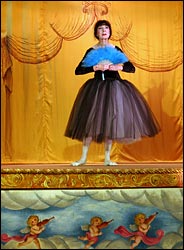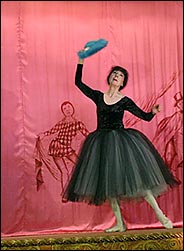
back
Want to support Global Action on
Aging?
Click below:

Thanks! |
 |
In a Desolate Town, Her Dreams a Bit Faded, an Aging Dancer Hangs On
By
Charlie LeDuff, the New York Times
January
14, 2004

DEATH VALLEY JUNCTION, Calif -
Madam Marta Becket can be found on certain afternoons drifting
about the adobe colonnades wearing a black boa, gold hoop earrings, soft
shoes and blue eye shadow.
With her long, slender legs and a small,
birdlike voice, Madam Becket is the resident diva of this desert ghost
town, the star of the Amargosa Opera House, its paint cracked and peeling,
its stage lights built from coffee cans. She is also its owner, manager,
choreographer, seamstress, prop master and ticket taker.
She gives 50 performances a season, from
October through May, in this theater she created more than three decades
ago from the abandoned social hall of the Pacific Borax Company. But how
long she can go on is anyone's guess. She is 79, needs a knee replacement,
smells faintly of liniment oil and, to conserve her strength, sleeps most
of the afternoon before performances. The doctor has recommended that she
call it a career.
If Madam Becket stops dancing and singing,
though, there will be no income to pay the property taxes, and eventually
the opera house, the motel and the rest of this old town that she bought
and resurrected from the devil will return to the devil, and to dust.
"Impossible!" she says of that prospect, sitting in one of the
$15 seats of her penny opera house, near the gas stove. "How tedious
the whole business has become."

She sits erectly, haughty in movement. She
sweeps her hand across the panorama of what she has created in the shadow
of the sun. Her manner brings to mind Norma Desmond.
The creep of age is unfair but unstoppable,
Madam Becket says. That is the bad part of life, but without death there
would be no urgency. There would be no need to create anything of virtue,
no necessity to make use of one's time. There would be no Amargosa Opera
House.
It was 36 years ago that as a traveling
stage performer, she was stranded in
Death Valley
with a flat tire. While the man who was then her husband repaired the
flat, she investigated the town. It was rotting, abandoned and desolate,
but Madam Becket, a New Yorker by birth and training, whose credits
include Broadway and
Radio
City
, imagined a future for herself inside the crumbling walls of the social
hall.
In the beginning, when no one came, she
painted murals of a 16th-century Spanish audience on the opera house
walls, to at least have someone to dance for. Now they come from
Las Vegas
and as far away as
Germany
, or just the casino seven miles up the highway, across the
Nevada
state line, to see Ms. Becket perform the pieces that she writes and
choreographs.
Men have come around with promises to help
preserve the place, she says. But in the end they seemed to her to be
shyster developers trying to steal her legacy and her 300 acres of prime
tourist land at the crossroads of
Death Valley
National Park
.
"I created the second half of my life
here," she says. "I don't want to see it disappear."
Historical societies and state universities
expressed interest until they found out that the town had no endowment for
its upkeep. An architect who attended the performance on Saturday said the
roof was long past its worth.
On some evenings, her partner, Tom Willett,
75, the only other resident of Death Valley Junction, cranks up his
calliope, and the eerie sound of a carnival drifts across the desert. A
child is said to haunt Room 22 of the motel, and coyotes yip at the
low-hanging moon. The place gives off the exciting palpitation of death,
and one cannot help admiring Madam Becket and Mr. Willett, and the lives
they have made in one of the most inhospitable places on earth.
"Oh, there are things I miss about
New York
," she says, growing animated with the memories, her dark eyes
flashing near the gas stove. "Window shopping on
Fifth Avenue
, I always loved that. The carousel in
Central Park
. Confirmation day on
Ninth Avenue
with the little girls in their white dresses and gloves. It used to be
such a wonderful city."
Her career started at the Hula Hut in the
Bronx
on New Year's Eve, 1943. She had been told they had an orchestra, so she
brought sheet music. It was an orchestra of sorts: a piano, trap drums and
an inebriated saxophone player. After the show, she stared into the
cracked dressing mirror and said to herself, "Where can I go from
here?"
Madam Becket says that a show has never been
canceled at her opera house because of illness or lack of interest and
that the curtain has always gone up at precisely
8:15 p.m.
In the second half of her life, she has
become something of a living treasure, the subject of documentary films,
magazine articles and local dinner conversation. She has a message for the
New York
artist.
"While you have time left, find a place
where you can live out your dreams," she says. "Even if it is on
top of a mountain or in the middle of a desert."
Copyright © 2002 Global Action on
Aging
Terms of
Use | Privacy
Policy | Contact Us
|

